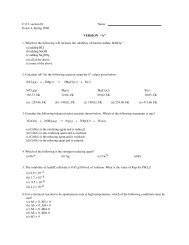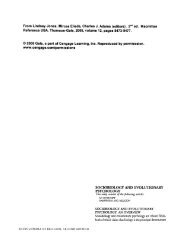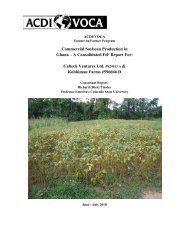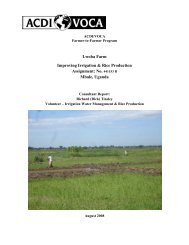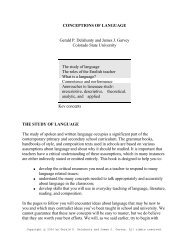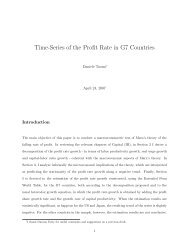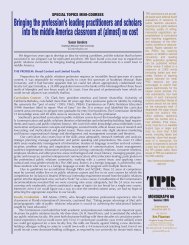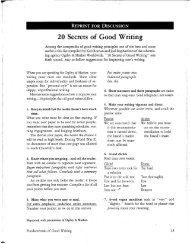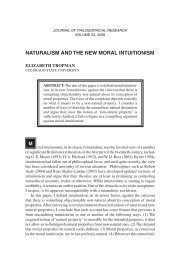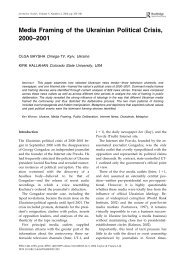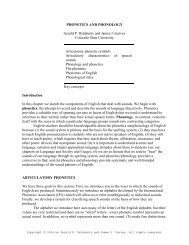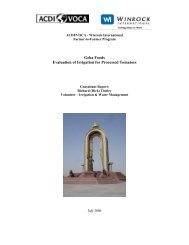Trail Log 1995-1997 - Lamar at Colorado State University
Trail Log 1995-1997 - Lamar at Colorado State University
Trail Log 1995-1997 - Lamar at Colorado State University
Create successful ePaper yourself
Turn your PDF publications into a flip-book with our unique Google optimized e-Paper software.
and barely survived.<br />
Antechinus stuartii, Common Antechinus, the size of a r<strong>at</strong>, came into the kitchen to clean up the<br />
scraps. Seen e<strong>at</strong>ing an avocado. A marsupial carnivore, but it e<strong>at</strong>s avocados anyway. E<strong>at</strong>s<br />
insects, arthropods.<br />
About 9.00 <strong>at</strong> night, a visit by her womb<strong>at</strong>. It is now wild, though she once raised it, after its mother<br />
was killed. It scr<strong>at</strong>ched on the outside door, came in, <strong>at</strong>e two carrots and barley flakes by the fire<br />
for 30-40 minutes. I took several pictures. Vomb<strong>at</strong>us ursinus. A somewh<strong>at</strong> relict group, most of<br />
them became extinct before humans reached Australia. Now found only in s.e. Australia, a r<strong>at</strong>her<br />
limited distribution. It grazes in her yard <strong>at</strong> times. She puts up a fence to keep out the kangaroos,<br />
though she has to make a womb<strong>at</strong> g<strong>at</strong>e because she can't keep it out. It digs under the fence or<br />
tears it down.<br />
We spent the night in the guest house. Cold, but <strong>at</strong> least warm under the covers.<br />
July 26, Friday. Left <strong>at</strong> 6.15 a.m., driving out the 5 km. driveway in the dark, though it was light by<br />
the time we reached the g<strong>at</strong>e. Drive back to Canberra. Jane saw one kangaroo on the side of the<br />
road. I missed it. Gas and regrouped <strong>at</strong> Queanbeyan. Airport, and flight to Melbourne, short flight.<br />
Car rental, and found hotel. Lygon Lodge. Drove to Dandenong Ranges N<strong>at</strong>ional park, in terrible<br />
traffic. This is about 20 miles east of Melbourne. When we eventually got there there were some<br />
quite impressive tall Eucalyptus trees, Eucalyptus regnans, tall, spectacular for their columnar<br />
appearance. There are 38 species of ferns and fern-like plants here. The park is generally under<br />
siege by the city, but there are determined efforts to preserve it. Return after dark.<br />
July 27, S<strong>at</strong>urday. Trip to Phillip Island. Drove to Dandenong and the car gave trouble shifting.<br />
So we swapped it for a Ford <strong>at</strong> Budget Car in Dandenong. Drove on down south. South Gippland<br />
Highway, and thence Bass Highway, then onto Phillip Island. Visited Koala Conserv<strong>at</strong>ion Centre,<br />
and had quick lunch. These are fenced koalas, though in a large area in n<strong>at</strong>ural habit<strong>at</strong>. Nine<br />
koalas, some on a boardwalk maybe 20 feet high. All asleep.<br />
Drove on to Cowes, and took bo<strong>at</strong> to see Australian fur-seals, Arctocephalus pulsillus. There are<br />
4,000 or so here; which we saw. We saw thousands on the rocks and a hundred or so swimming<br />
in the w<strong>at</strong>er beside the bo<strong>at</strong>, popping up to take a look <strong>at</strong> us. Spectacular. They were so inquisitive<br />
as to suggest th<strong>at</strong> they had <strong>at</strong> other times been fed, but there was no feeding while we were there.<br />
Seals have no external ears. The Australian sea-lion (Neophoca cinerea) is also on the southern<br />
coast of Australia, but not here, and has external ears.<br />
Lots of cormorants and gulls also seen. Kelp gull. Pacific gull. Pied cormorants, mostly. Little pied<br />
cormorants. Gre<strong>at</strong> black cormorant. Silver gulls, seen on grassy Nobbies.<br />
Returned by bo<strong>at</strong> closer in to sea caves.<br />
Went to the penguin parade. Little (Fairy) Penguin. This is the only penguin to make its base in<br />
Australia. They came out of the ocean in groups of 12-15, starting <strong>at</strong> 5.45 p.m. in the dark. We<br />
saw perhaps 200, some closer in. The waves would come in and knock a whole group over. They<br />
would g<strong>at</strong>her and then run across the beach and into a hill covered with low veget<strong>at</strong>ion where they<br />
had burrows. The males are staking out territories, <strong>at</strong> this time of year. They had been <strong>at</strong> sea<br />
feeding for the day. Various ones were seen closer <strong>at</strong> hand as we returned up the boardwalk.



